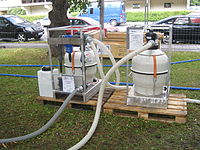Point-of-use water treatment

Hey kiddo! Today we are going to talk about something called point-of-use water treatment. Have you ever heard of it?
Well, do you know how we get clean water to drink and use at home? It usually comes from a big water treatment plant where they clean and purify the water before sending it to our homes. But what if you don't live near a treatment plant, or what if there is a natural disaster like a flood or earthquake that makes it hard to get clean water?
That's where point-of-use water treatment comes in! It means cleaning and treating water right where it's being used, like in a home or a school. This makes sure the water is safe to drink and use, even if there is contaminated water around. There are many different ways to do this, but here are a few examples:
One common way is using chemicals like chlorine or iodine to kill any germs or bacteria in the water. Think of it like hand sanitizer for the water!
Another way is using a filter to physically remove any dirt, dust, or tiny particles in the water. It's like putting a strainer over your cup so only clean water goes through.
There are also some more advanced methods like using ultraviolet light or reverse osmosis, but those can be harder to do at home.
Overall, point-of-use water treatment is a really important way to make sure everyone has access to clean and safe water, no matter where they are. Did that explanation help?
Well, do you know how we get clean water to drink and use at home? It usually comes from a big water treatment plant where they clean and purify the water before sending it to our homes. But what if you don't live near a treatment plant, or what if there is a natural disaster like a flood or earthquake that makes it hard to get clean water?
That's where point-of-use water treatment comes in! It means cleaning and treating water right where it's being used, like in a home or a school. This makes sure the water is safe to drink and use, even if there is contaminated water around. There are many different ways to do this, but here are a few examples:
One common way is using chemicals like chlorine or iodine to kill any germs or bacteria in the water. Think of it like hand sanitizer for the water!
Another way is using a filter to physically remove any dirt, dust, or tiny particles in the water. It's like putting a strainer over your cup so only clean water goes through.
There are also some more advanced methods like using ultraviolet light or reverse osmosis, but those can be harder to do at home.
Overall, point-of-use water treatment is a really important way to make sure everyone has access to clean and safe water, no matter where they are. Did that explanation help?
Related topics others have asked about:
